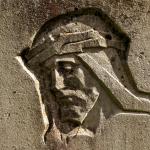He suffered under Pontius Pilate,
was crucified, died, and was buried.
He descended to the dead.
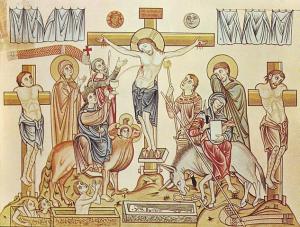 The next clause of the Apostles’ creed focuses on the death of Jesus the Christ. The first line reiterates his life and place in history. Ben Myers (The Apostles’ Creed) focuses on the word suffered. This word emphasizes the nature of Jesus life and his death. “When ancient people heard the gospel they were tempted to think of Jesus as a supernatural spirit, untouched by physical life.” (p. 59) The Jesus in whom we believe was a human being who suffered in the flesh.
The next clause of the Apostles’ creed focuses on the death of Jesus the Christ. The first line reiterates his life and place in history. Ben Myers (The Apostles’ Creed) focuses on the word suffered. This word emphasizes the nature of Jesus life and his death. “When ancient people heard the gospel they were tempted to think of Jesus as a supernatural spirit, untouched by physical life.” (p. 59) The Jesus in whom we believe was a human being who suffered in the flesh.
Only three humans are identified by name in the creed – Jesus, Mary, and Pilate. Jesus and Mary we understand, but Pilate? This is an important reference. Ben Myers, J.I. Packer (Affirming the Apostles’ Creed), Michael Bird (What Christians ought to Believe) and Derek Vreeland (primal credo) all make this point in different ways. Myers puts it well: “At the center of the creed is a story, or at least the summary of a story. We are meant to take our bearings not just from doctrine but from history: from a sequence of events that occurred in a particular time and place.” (p. 62) As Vreeland says “Naming Pilate in the creed anchors the life and death of Jesus in time and space.” (p. 56)
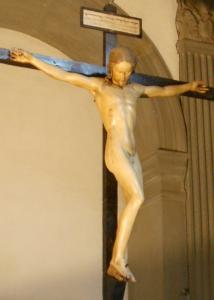 Crucified. The death of Jesus on a Roman cross just outside Jerusalem is the image of Christianity. Crucifixion was a torturous and ignominious manner of death. For both Jew and Greek it was a shameful death intended to remove all dignity and humanity from the victim. It was a public disgrace and a public spectacle that brought ridicule and taunts from the crowd. Naked, half dead men lingered in full view as they bled and died – usually from asphyxiation. It was, Bird reminds us, “the punishment of slaves, bandits, and enemies of the state.” (p. 115) This death, however, quickly became the symbol of Christianity. The Philippian overseers and deacons are told by Paul to have the same mind as Christ Jesus who “emptied himself, taking the form of a slave, … he humbled himself and became obedient to the point of death – even death on a cross.” (2:7,8)
Crucified. The death of Jesus on a Roman cross just outside Jerusalem is the image of Christianity. Crucifixion was a torturous and ignominious manner of death. For both Jew and Greek it was a shameful death intended to remove all dignity and humanity from the victim. It was a public disgrace and a public spectacle that brought ridicule and taunts from the crowd. Naked, half dead men lingered in full view as they bled and died – usually from asphyxiation. It was, Bird reminds us, “the punishment of slaves, bandits, and enemies of the state.” (p. 115) This death, however, quickly became the symbol of Christianity. The Philippian overseers and deacons are told by Paul to have the same mind as Christ Jesus who “emptied himself, taking the form of a slave, … he humbled himself and became obedient to the point of death – even death on a cross.” (2:7,8)
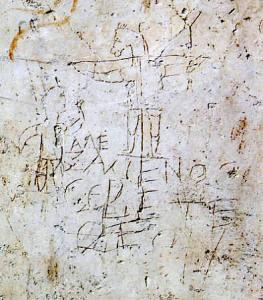 The cross was a stumbling block to the Jews (a curse on anyone hung on a tree) and foolishness to the Greeks. A fascinating piece of graffiti from sometime around 200 AD (see here) points to the foolishness of Christians – worshiping a crucified god. The writing is translated as “Alexamenos worships [his] God.”
The cross was a stumbling block to the Jews (a curse on anyone hung on a tree) and foolishness to the Greeks. A fascinating piece of graffiti from sometime around 200 AD (see here) points to the foolishness of Christians – worshiping a crucified god. The writing is translated as “Alexamenos worships [his] God.”
As Christians we embrace the message of the cross. We are called to emulate the humility it represents. There is much more to be said on this topic. Paul preached the message of cross and wrote to the Corinthian church “For the message of the cross is foolishness to those who are perishing, but to us who are being saved it is the power of God.” (1 Cor 1:18) We could do a whole series of posts on the importance of the cross in Paul’s epistles – but will leave it here for now.
Michael Bird summarizes:
Despite the mockery and shame associated with crucifixion and despite the utter folly of a crucified Messiah to all and sundry, the early church narrated the story of the cross as the climax of God’s plan, and they embraced the symbol of the cross as the instrument through which God’s kingdom was achieved. If we are to live out the story of the cross, then one of the first things we have to do is get inside the passion story and grasp, not superficially but on a deep level, the full sweep of the story of the cross. (p. 120)
The creed affirms our belief in Christ crucified and all it stands for.
Died and buried. Jesus died in the flesh and was buried in the earth. He didn’t appear to die or simply leave his earthly body without experiencing death. Jesus really died – and the death from which he arose was a real one. That Jesus died a real death is a necessary element of the victory over death achieved in the resurrection. Ben Myers points out the importance of this idea in the early church – Irenaeus emphasized that Jesus experienced what we experienced from birth to death and by walking through these steps he redeemed them for us. Myers summarizes Gregory of Nyssa noting that “Jesus would not really of shared our nature if he had not also shared its limits. Everyone comes into the world through the womb and departs into the tomb. And so the Son of God embraced out humanity at these extreme limits.” (p. 75)
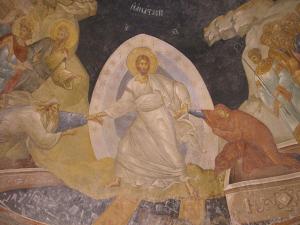 He descended to the dead. The older form of the creed has He descended into Hell. This, however, is not a proper understanding of the phrase in the original Greek. Packer, Myers, and Bird all emphasize this in their books. The word Hell is misleading here because if conjures up an image of punishment and suffering. The Greek Hades or Hebrew Sheol are better terms to consider. Jesus was really and truly dead. He descended to the place of the dead. This phrase strengthens the prior statement that he died and was buried by emphasizing that his fate was the same as all who died – he went to the place of the dead, to Hades. It is from the place of the dead that he arose. On the island of Patmos John received a vision “Do not be afraid. I am the First and the Last. I am the Living One; I was dead, and now look, I am alive for ever and ever! And I hold the keys of death and Hades.” Rev. 1:17-18. He holds the keys of Hades because he experienced death in its fullness.
He descended to the dead. The older form of the creed has He descended into Hell. This, however, is not a proper understanding of the phrase in the original Greek. Packer, Myers, and Bird all emphasize this in their books. The word Hell is misleading here because if conjures up an image of punishment and suffering. The Greek Hades or Hebrew Sheol are better terms to consider. Jesus was really and truly dead. He descended to the place of the dead. This phrase strengthens the prior statement that he died and was buried by emphasizing that his fate was the same as all who died – he went to the place of the dead, to Hades. It is from the place of the dead that he arose. On the island of Patmos John received a vision “Do not be afraid. I am the First and the Last. I am the Living One; I was dead, and now look, I am alive for ever and ever! And I hold the keys of death and Hades.” Rev. 1:17-18. He holds the keys of Hades because he experienced death in its fullness.
Jesus was truly humiliated and shamed, he was rejected and suffered extreme physical and mental pain. This happened at a specific time and place in history. He physically died as all humans die and descended to the place of the dead. In the next few lines we come to the victory over death. But that is for the next post in this series.
What is the most significant part of this portion of the creed?
What does it mean for you? for the church?
If you wish to contact me directly you may do so at rjs4mail[at]att.net.
If interested you can subscribe to a full text feed of my posts at Musings on Science and Theology.














